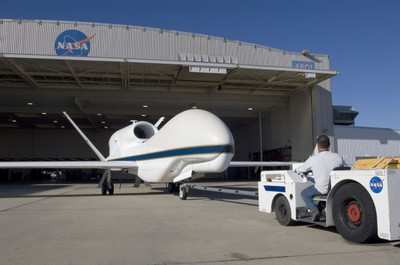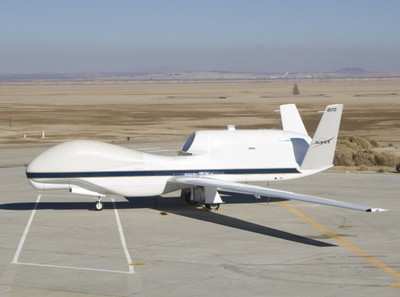Specially-Equipped RQ-4s Have Already Flown To North
Pole
NASA's Dryden Flight Research Center and the Northrop Grumman
Corporation have reached an agreement that will enable NASA's
Science Mission Directorate to conduct Earth science research with
the Northrop Grumman-developed RQ-4 Global Hawk unmanned aircraft
system.

Under a Space Act Agreement signed April 30, NASA and Northrop
Grumman will bring to flight in 2009 two pre-production Global Hawk
aircraft that were recently transferred to NASA. Northrop Grumman
will share in their use to conduct its own flight demonstrations
for expanded markets, missions and airborne capabilities, including
integration of unmanned aircraft systems into the national
airspace.
 The two Global Hawk aircraft, among
the first seven built during the original Defense Advanced Research
Projects Agency sponsored Advanced Concept Technology Demonstration
program, were transferred to NASA Dryden from the US Air Force in
September 2007. NASA acquired the two aircraft for research
activities supporting its Airborne Science Program.
The two Global Hawk aircraft, among
the first seven built during the original Defense Advanced Research
Projects Agency sponsored Advanced Concept Technology Demonstration
program, were transferred to NASA Dryden from the US Air Force in
September 2007. NASA acquired the two aircraft for research
activities supporting its Airborne Science Program.
"This innovative partnership not only provides for the
activation of the Global Hawk flight operations at NASA Dryden, but
also sets the stage for an exciting future of collaborative science
missions and technology experiments," said Kevin L. Petersen, NASA
Dryden director. "The capabilities of this platform are unique and
will provide NASA and Northrop Grumman some exceptional
opportunities to advance technology and science through
flight."
As the world's first fully autonomous, high-altitude,
long-endurance unmanned aircraft system, Global Hawk can fly up to
65,000 feet for more than 31 hours at a time. The aircraft have a
range of 11,000 nautical miles. Its endurance and exceptional range
allow for a non-stop flight from Dryden in Southern California to
the North Pole with a seven-hour loiter period before returning. To
date, Global Hawks have flown more than 22,000 hours in military
service with the Air Force.
The primary NASA sponsor is the Earth Science Division of the
Science Mission Directorate. The division is developing plans to
capitalize on the extreme range and dwell time of the Global Hawk
for atmospheric chemistry and radiation science missions in
addition to hurricane research.
"We are looking forward to working with our National Oceanic and
Atmospheric Administration and Department of Energy partners to
explore the unique capabilities of the Global Hawk to augment the
current satellite and aircraft based observation systems NASA
uses," adds Dr. Michael Freilich, NASA's Earth Science Division
director, NASA Headquarters in Washington.
Global Hawk also has many potential applications in addition to
the advancement of science, including development of disaster
support capabilities and development of advanced unmanned aircraft
systems technologies. As ANN reported, a converted
USAF Global Hawk was used in October 2007 to monitor wildfires in
Southern California.

"Global Hawk's range, endurance and altitude make it
particularly suited to a broad range of applications," said Corey
Moore, sector vice president of Advanced Concepts and Integrated
Solutions for Northrop Grumman. "Access to these two flight test
vehicles will allow us to more fully explore new potential missions
for this remarkable system."
 NTSB Prelim: Lee Aviation LLC JA30 SuperStol
NTSB Prelim: Lee Aviation LLC JA30 SuperStol Classic Aero-TV: Curtiss Jenny Build Wows AirVenture Crowds
Classic Aero-TV: Curtiss Jenny Build Wows AirVenture Crowds ANN's Daily Aero-Term (05.30.25): Very High Frequency (VHF)
ANN's Daily Aero-Term (05.30.25): Very High Frequency (VHF) Aero-News: Quote of the Day (05.30.25)
Aero-News: Quote of the Day (05.30.25) Classic Aero-TV: Quest Kodiak Enhances Migration Monitoring Programs
Classic Aero-TV: Quest Kodiak Enhances Migration Monitoring Programs





